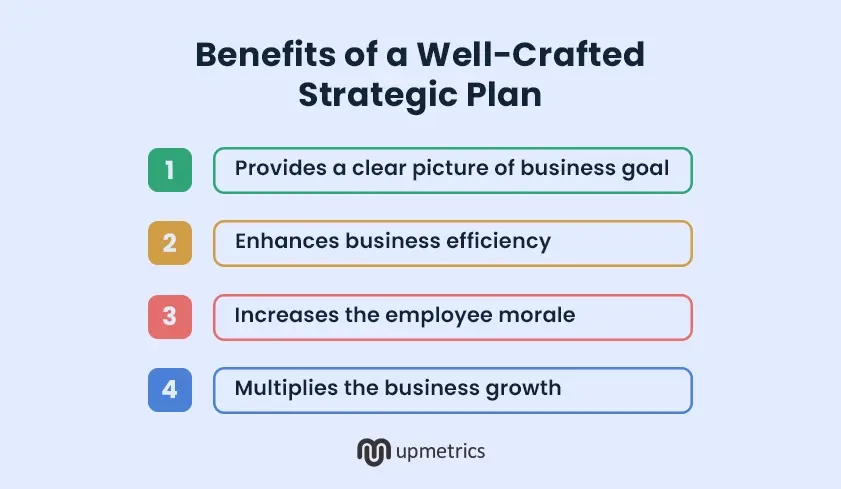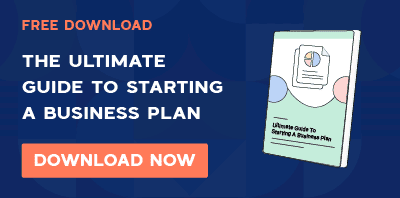A thriving business doesn’t grow by chance—it grows with purpose and direction.
Strategic business planning is the blueprint that guides this growth. It empowers businesses to navigate challenges, capitalize on opportunities, and set a path toward their long-term vision.
By setting actionable goals and aligning resources effectively, strategic planning becomes the foundation for a business’s future.
But what exactly is strategic business planning and is it really essential for all businesses? Well, let’s uncover it in this blog post with examples.
What is strategic planning?
Strategic planning is the process of defining your long-term business goals and the actions needed to achieve them. It involves setting a vision, analyzing internal and external factors (such as market conditions), and creating a roadmap that aligns resources and efforts with the company’s objectives.
Simply put, strategic planning aims to answer the three fundamental questions:
- Why: Why does your organization exist (vision)
- What: What needs to be done to achieve your vision (strategy)
- How: How will you implement the strategies to accomplish your vision? (execution)
→ Download Now: Guide on Writing a Business Plan
Step-by-step guide to strategic business planning
Strategic planning provides essential clarity and direction to achieve your long-term goals. It helps businesses make informed decisions and guide them to allocate their resources to drive sustainable growth.

We have this step-by-step guide that will help you drive your strategic planning process toward success:
1. Define your business vision
Begin by clearly defining your business mission and vision, i.e. where you want to take your business.
However, before that, get a thorough understanding of where your business stands today. Analyze your competitors and understand your strengths. Get a nuanced understanding of how your business operates and what drives its profitability. This understanding will help you set realistic expectations for your long-term goals.
The vision of your business will be the central focal point of your strategic plan. Be extremely specific and define where is it that you expect your business to be in the next 5-10 years. For instance, being a market leader by 2030.
2. Build the right team
Strategic planning sets the direction for your entire business. Naturally, you shouldn’t be the only one involved in this process.
Involve your top management, operational heads, board members, and key employees in the goal setting and strategic planning process. If required, you can also take the help of consultants and advisors to streamline your strategic planning.
Hold strategy brainstorming sessions, discuss the issues, and try to find the best strategies and tactics to drive your business to its ultimate goal.
Pro tip: Assign clear roles and responsibilities to the team to develop an efficient and effective business strategy.
3. Set your strategic goals
Define your long-term goals for the business ensuring its alignment with your vision. It can be a managerial, financial, operational, or any relevant goal that would take you closer to your ultimate vision.
For instance, if your goal is to become a market leader by 2030, your long-term goals can be
- Expanding into 10 new locations
- Capturing 25% market share
- Achieve $5 Million in revenue
- Starting an in-house production
Further, break your long-term goals into smaller annual, quarterly, and monthly goals. Use a SMART goal framework to help you set the most defined goals. Smaller goals when aligned with your ultimate vision help you stay on track.
4. Develop strategies and tactics
Now that you have your goals defined, it’s time to work on your strategy and tactics.
Create a strategic plan or use strategic model canvases to pull together your ideas. Identify the key initiatives, resources, and processes required to achieve your long-term goals.
Define the processes and workflows needed to execute these strategies efficiently. Set clear timelines, assign responsibilities, and create communication channels to ensure coordination across teams.
Tip: Ensure that your tactics are flexible enough to adapt to changing conditions helping you remain agile.
5. Execute your plan
Execute your strategies and monitor the progress to help you stay on track. Assess your progress using KPIs by comparing the actuals against set goals.
Conduct periodic reviews to evaluate whether the strategy is working and make necessary adjustments to adapt to changing conditions.
That said, don’t rush into the process of strategy planning. It’s going to drive the course of your business so dedicate your time and resources to get it right.
What to include in a strategic business plan?
Planning is a long-term commitment for your business. You not only have to create a well-rounded strategic plan but also update it frequently.
While there’s no fixed blueprint for how you structure your strategic plan, you may consider including the following details to make your strategic plan effective.
- Vision statement: This statement consists of where and how you want to see your business in the next 5-10 years.
- Core objectives: This element involves setting specific goals for your business such as increasing the market share by 15% or getting big clients.
- External factors: This includes external factors or factors out of your control that are likely to affect your business such as demand for products, financing possibilities, etc.
- Action plan: This includes key initiatives, competitive advantages, and a strategy detailing how you’ll achieve goals.
- Resource allocation: Outlines how the organization will arrange and utilize its resources, such as finances, human capital, and technology.
- Performance measurement and KPIs: Establishes key performance indicators (KPIs) and evaluation metrics to track the plan’s progress.
By incorporating these elements, the strategic business planning process becomes a comprehensive and adaptable roadmap. It guides an organization toward its goals, maximizes growth potential, and helps make informed decisions.
Benefits of a well-crafted strategic plan
Strategic business planning helps you be proactive and make the business prepared for future challenges. It makes your business more agile helping you adapt quickly and seize new opportunities.

Well, let’s now understand the benefits of having a well-crafted strategic plan:
1. Provides a clear picture of business goal
Strategic planning ensures that everyone within the organization aligns with a unified vision. It fosters responsibility among the employees and stakeholders by clarifying the company’s goals and their roles in its achievement.
2. Enhances business efficiency
A well-developed strategic plan streamlines the workflow and guides efficient resource allocation. It identifies inefficiencies in your business processes and empowers you to make guided data-driven decisions.
3. Increases the employee morale
When the tasks are communicated clearly to employees, they perform them better and more efficiently. They know what they need to do, giving them a sense of responsibility toward the business. This helps them feel like an integral part of the business and encourages them to perform using their full potential.
4. Multiplies the business growth
The process of strategic planning is set with a futuristic vision in mind. By taking logical and well-analyzed steps, business threats can be handled well, and opportunities can be magnified. In addition, the support from employees and the coordination between various departments of your business bring stability to the table. With such harmony in place, your business growth can multiply sooner than anticipated.
Now, that you understand the benefits of a strategic plan, let’s now clarify our understanding with examples.
Strategic business plan example
Often there seems to be confusion between a strategic business plan and a business plan. In reality, both have vast differences. A business plan sets the planning for short-term to medium-term visions and goals. While the latter centers on long-term objectives, setting a broader vision and roadmap for growth and competitive positioning within the market.
Here are different strategic business plan frameworks that can guide you in setting a business vision and achieving goals:
A SOAR analysis
This analysis is an updated version of the SWOT analysis. SOAR means Strengths, Opportunities, Aspirations, and Results. The two eliminations of SWOT – Weakness, and Threat are replaced with positive ones here. This gives SOAR analysis a more positive outlook compared to SWOT.
The porter’s five forces
This in-depth example examines external factors that can affect your business. The Five Forces considered in this analysis are:
- The power of suppliers
- Competitive rivalry
- The power of buyers
- The threat of a new entry
- The threat of substitute products.
Porter’s 5 forces help your business gauge the market scenario, identify potential challenges, and improve strategy for better market positioning.
STEEPLE
It stands for the following.
- Social: Any change in demographic or lifestyle trends or patterns.
- Technological: New technological advancements that can help your business improve or grow.
- Economic: The inflation rate, rate of interest, etc. of the country you are conducting your business in.
- Environmental: Any change in the way regulators and consumers perceive sustainable development.
- Political: Change in government, regulations, taxation, etc.
- Legal: Changes in legal aspects and systems that can affect your business.
- Ethical: Implementation of ethical policies and moral standards.
NOISE
This analysis is the acronym for Needs, Opportunities, Improvements, Strengths, and Exceptions. NOISE is an improvement-based method. It has a futuristic view that helps your business identify areas for enhancement and growth.
CORE analysis
A CORE analysis, as the name suggests, looks at the core financial health of a business. It assesses capital raised, investments made, ownership structures, risks involved, and investor relations. Performing this analysis helps you get a clear understanding of the financial health of your business.
That said, each business should evaluate its unique needs, challenges, and goals to choose the strategic framework that best aligns with its vision and long-term objectives. The right framework can guide effective planning, drive growth, and help navigate market complexities confidently.
Create your strategic business plan with Upmetrics
Strategic business planning is crucial for businesses to grow, adapt, and succeed in today’s competitive environment. By selecting the right framework and conducting regular reviews, businesses can align their goals, make informed decisions, and maximize opportunities.
Be it a new or an established business—Upmetrics’ strategic planning tool streamlines the creation, management, and execution of your business strategy. With its strategic planning templates, detailed guides, and robust planning tools, you can craft a strategy that resonates with your vision.

